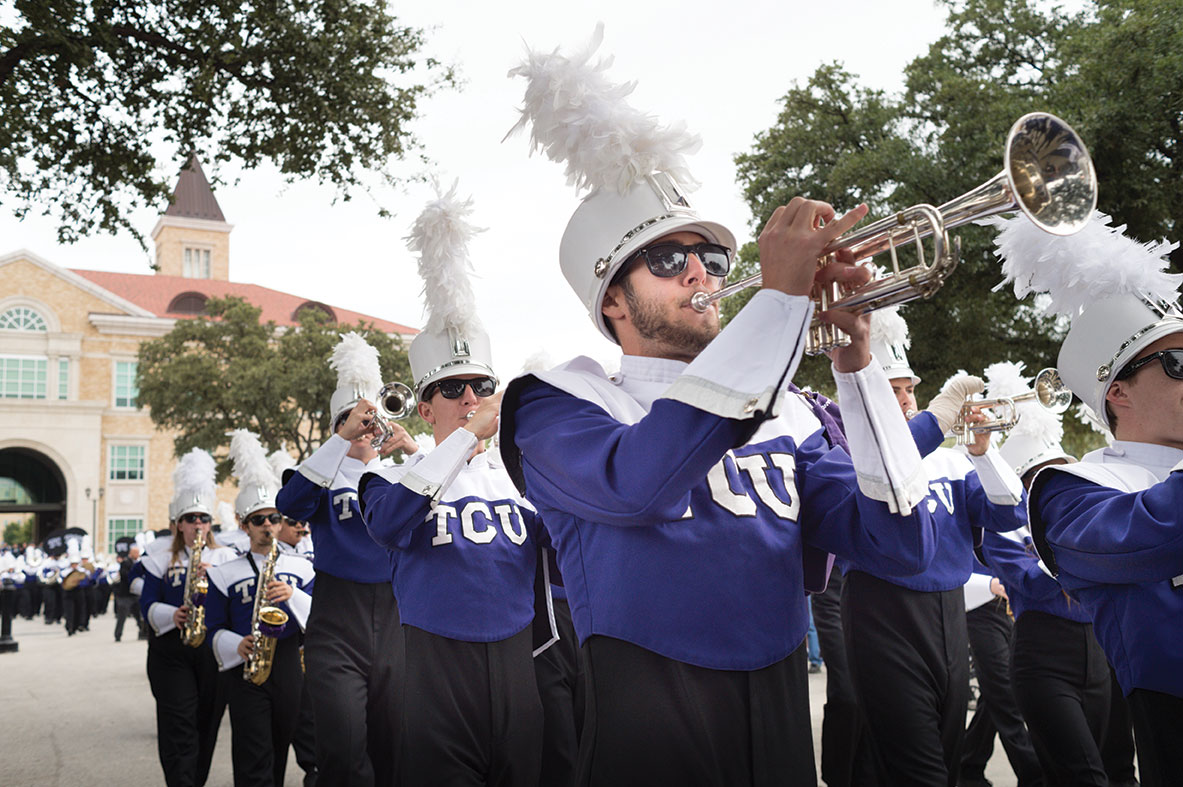

Our Marching Band, the Pride of TCU
In its 111th year, the band still practices hard, relies on teamwork and performs with passion.
Click. Click. Click. Click.
Drum line captain Mitch Tasker cracks hickory sticks against the side of his snare drum.
Rat-a-tattle and a flam-a-diddle. With 30 percussionists in rhythmic union, the Pride of TCU marches as a collective rectangle for the band’s 111th season.
Left foot. Right foot. One in front of the other. Rolling from heel to toe, the band floats onto the field of Amon G. Carter Stadium.
In a flurry of crescendoing accents, the 205 members of the 2015 marching band turn in slow synchronized circles to face the stadium’s east side.
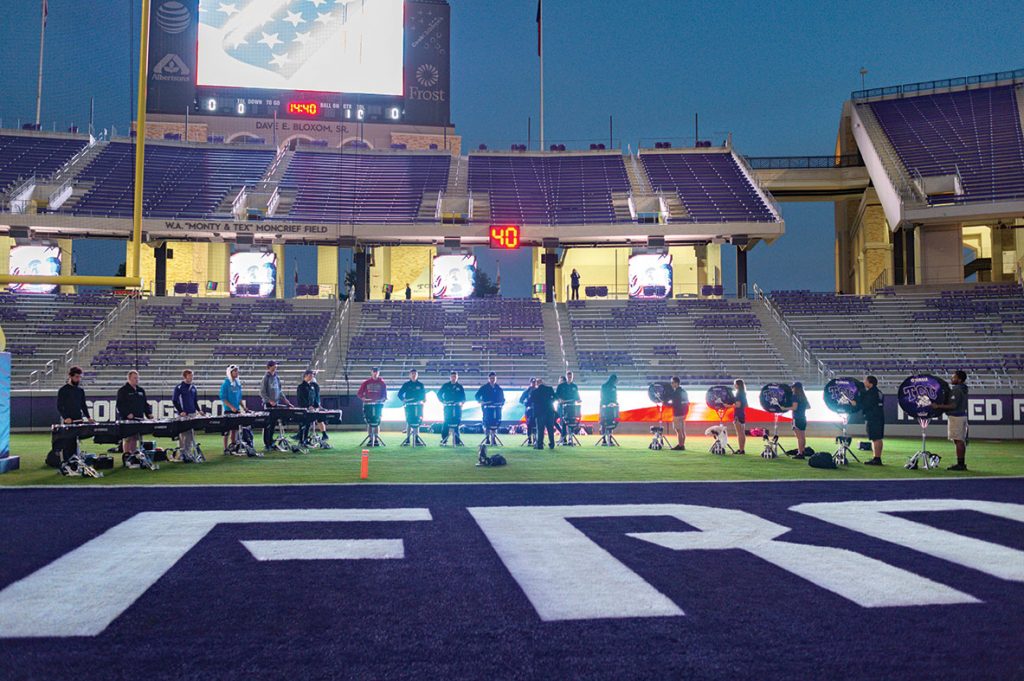
Game day practice starts before the sun comes up.
Showgirls assemble in three diamond formations in front of the musicians. The flag-twirling colorguard stretches in a straight line behind. The ready-for-battle drum cadences give way to an explosive and variegated melody, punctuated by trilling piccolos and anchored by the low hum of trombones.
After a few measures, each section turns askance. Chaos. The clarinet players weave through the oncoming saxophonists to form a curving arc opposite the bass drummers, who pound the rhythmic backbone of the season’s first halftime show.
The movement halts.
Two drum majors on either 35-yard line stare at the head drum major. Melissa Camp stands on a tall podium in the middle of the sideline, chin high, keeping time with two hands ringed by white gauntlets.
Following Camp’s direction, the band rearranges into the curling tendrils of paisley. No one misses a beat.
Band Camp
Marching band season didn’t start with the halftime show’s perfect alignment. The road to togetherness begins in early August when drum camp convenes on a nearly empty campus.
On a Thursday morning, before the worst of the summer sun boils the day, the sounds of music are more rudimentary: eight strokes with each stick battered into an assortment of drums, repeated at an accelerating pace.
“It always comes back to technique,” Tasker said about the warm-up routine, which begins drum line practice every day, every year.
Auditions for specific drums happen fast. Then the group starts learning the dozens of songs and cadences to be played at the stadium. Some musical pieces are so historic, Tasker said, “There’s not music for them anymore. They’re just taught by rote.”
Fellow drummer Zach Montez said camp involves more than songs. “You need to be listening, and you need to be able to play [everyone’s] part.” A lot to remember, yes, but, “It makes you a great musician.”
(Video courtesy of the TCU drumline)
A few days later, the rest of the band arrives. On the painted-to-look-like-a-gridiron concrete of parking lot two, down the hill from the stadium’s towering west side, musicians, colorguard and two baton twirlers spend five days, from sunup to sundown, practicing, living and breathing the Horned Frog Marching Band.
Pausing for a water break after rehearsing the “TCU Fight Song” on Wednesday morning, trumpeter Miku Stone said that as a rising junior, she is comfortable with the routine, but her first college band camp “was pretty nerve-wracking.”
The Pride of TCU featured quadruple the members of Stone’s Oklahoma high school’s band. “It was the biggest surprise of my life,” she said. “Those first sounds just shocked me when everyone played as a unit.”
By Friday morning, the band has finished a run-through of marching fundamentals and pre-game formations. Now it is time to work on the first of its three halftime shows for the season.
Band Director Brian Youngblood creates musical theme years. For 2015 he chose a pop collection called “Get Your Groove On.”
First up: Songwriter Mark Ronson’s chart-topper “Uptown Funk.” The radio-friendly original featuring Bruno Mars is a mix of vocals, a drum kit and a few electronic instruments, but the marching band’s arrangement divides the song 200 ways. The flutes, trumpets and other instruments that tend to soar get the higher-pitched notes. The tubas, marimbas and baritone saxophones take responsibility for the low end.
Tying the composition together are the perfected-down-to-the-millisecond undulations of the drums. The flickety-flickety baps and machine-like rrrroooollllllls build tension for the emerging chorus.
Marching season
At the high school level, many bands focus more on competitions than on entertaining football crowds. At universities, bands not only entertain, they set the tone for the gridiron experience.
Youngblood said: “We’re what I like to call the appropriate celebration of all the hard work you did to get good at your instrument.”
Tasker said TCU’s enthusiastic fans contribute to his enjoyment: “I felt so cool my first game my freshman year, coming into the new stadium and being part of the Big 12 and just seeing so many fans around the drum line.”
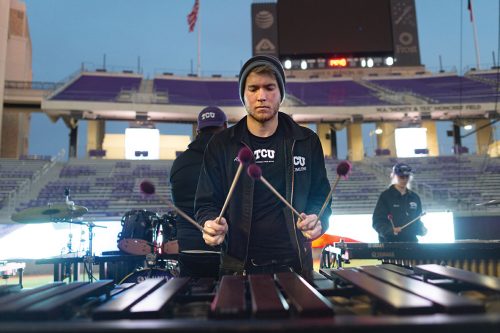
Jacob Arie rehearses a four-mallet marimba part in the drum line’s immobile percussion section, known as “the pit.”
Before the first 2015 home game, a midafternoon contest against Stephen F. Austin State University, the band dazzles the crowd with intricate drum patterns ringing off of the stadium’s concrete concourses. The energetic buzz ripples up into the stands.
With 20 minutes until the opening whistle, the band marches onto the middle of the field.
Volunteers spray water on the uniformed musicians before the national anthem, a pre-game staple highlighted by crashing cymbals. Trumpets announce the opening of the “TCU Alma Mater,” quieting the crowd. Fans clap in time with the “TCU Fight Song,” a 1928 composition by Claude Sammis, a former band director.
As the band marches off the field, the crowd shouts the chant. “Rah, rah, TCU! Rah, rah, TCU!”
As the football team builds a 35-0 first-half lead, the band keeps the crowd’s spirit high from the stands. It plays a selection of rhythmic ditties and melodic refrains, most no longer than the 15 seconds between plays.
At the half’s final whistle, the football team trots into the locker room. The band walks down its private staircase to show off the “Uptown Funk” extravaganza.
Youngblood wrote the drill, the geometric layout of 200 musicians flowing and re-arranging into compelling formations. He often adds maneuvers called “the moving diamond” and “the Jacobsen turnaround.” Both are inventions of legendary TCU Band Director Jim “Prof” Jacobsen. Some of his synchronized maneuvers are now staples in marching bands across the country.
Challenging the marchers to spin on a dime in the midst of music is fun, Youngblood said, but audience satisfaction is the driving motivation. “We create the show to get the most entertainment value.”
After the opening number, the drums take over. In a shift, they form horizontal lines in a new rectangle. The rest of the band stands at attention in vertical 5-yard intervals. The drum line launches into a cadence. It is a sacred sound for TCU fans, who chime in at the correct moment.
Brrrrap-dap, buh-duh-bedap. GO! Brrrrap-dap, buh-duh-bedap. GO FROGS!
Military roots and modern realities
Unlike some college bands, which stick to replicating decades-old traditions, the Pride of TCU experiments. In recent years, Youngblood’s bands featured the “Star Wars” theme song and Journey’s 1981 classic “Don’t Stop Believing.” But the band sometimes returns to more typical marching fare, including “Malagueña,” which it performed at the Rose Bowl in 2011.
No matter the music, the goal remains the same: Generate an awe-inducing wall of sound. “The marching band, when it was invented for American football at the turn of the century in the 1900s, was the loudest thing on earth that was musical,” Youngblood said.
In 1904, TCU, then located in Waco, established a 32-member, military-style band. Charles Kirkpatrick led the first version. His brother, Bedford Kirkpatrick, conducted a continuation in 1911 as administrators laid the cornerstone for Reed Hall on the university’s new Fort Worth campus.
In the 1930s, newspaper magnate Amon Carter chartered Pullman cars for the band so it could follow the Davey O’ Brien-era Fightin’ Frogs to big games in New York or the Sugar Bowl in New Orleans.
TCU boasts a big-time football history, and the band was always there as an essential element. In today’s high-stakes Big 12, large public universities field large bands, averaging about 350 musicians. Though smaller overall, with more than two members for every 100 undergraduate students, TCU has the highest rate of band participation in the conference. (The national level of marching band participation at the college level is about 1 percent.)
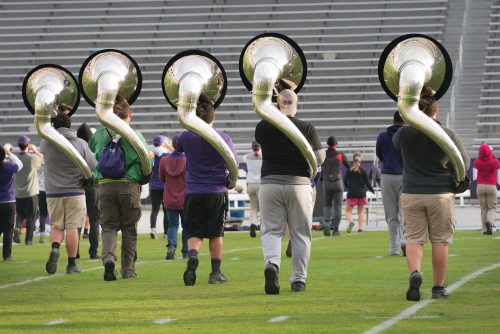
The sousaphones these TCU Marching Band members carry can weigh up to 35 pounds apiece.
But the university’s rise as an academic powerhouse affected the band. High-achieving students who were not majoring in music were less enthusiastic about donning purple-and-white band jackets. In 2014, the band’s ranks fell to about 150 people, mostly music majors.
To counteract the smaller size, and to deliver bigger sound in an expanded stadium, the athletic department amplified the band with microphones, broadcasting the music inside, outside, even in the restrooms.
The administration stepped in, too. Before the 2015-16 year, the university instituted a $3,000 stipend for each band member to collect at the end of marching season. Membership swelled to 205 students, representing a mix of majors.
Youngblood prefers to maintain the TCU Band tradition of keeping the approach fresh, a style on full display at the halftime show last September. A line of tubas, horns covered in black fabric with the TCU logo, owners dancing underneath, lay down the opening riff of the Horned Frog version of “Uptown Funk.”
Then, a surprise: TCU student Philip Antinone stands on the sideline in front of a microphone. As the band marches toward opposite sidelines, he belts out the song’s familiar verse: “This hit, that ice cold. Michelle Pfeiffer, that white gold.”
Staying in step
At midseason, when temperatures drop, the band moves onto its second well-rehearsed halftime performance, featuring a colorful version of J-Lo and Pitbull’s “On the Floor.”
Though marching band is an actual course netting a half-hour credit, the full band rehearses on Monday, Wednesday and Friday afternoons, and all day on any open Saturday.
“We don’t spend time in rehearsal learning notes,” Tasker said. “That’s what you’re supposed to do outside of rehearsal, and then you come ready to detail [the music] and work on dynamics and listening and balancing all the different instruments.”
Time management is an essential skill for college students, especially TCU music majors, who in 2015 constituted about half the marching band. School of Music students take about 18 semester hours if they plan to graduate in four years.
But “music major 18 hours are not like normal major 18 hours because we take a lot of half-credit hour classes that are really rehearsals,” said Marguerite Green, a 2015 drum major. She estimated practicing 15 solo hours each week on top of the in-class rehearsals. “I feel like we get a very different college experience than your stereotypical college student.
“The thing about being so busy, especially in the fall, is it really forces you to time manage,” Green said. “You have to get this done right now because you won’t have time to do it later. But I think it’s really good for us, especially as future teachers.”
Tasker said the cumulative rehearsal time strengthens bonds within the band. “It’s very difficult to join a fraternity or sorority, but what I’ve noticed … is you don’t want to,” he said. “You’ve already got your group of people that you can be that close with.”
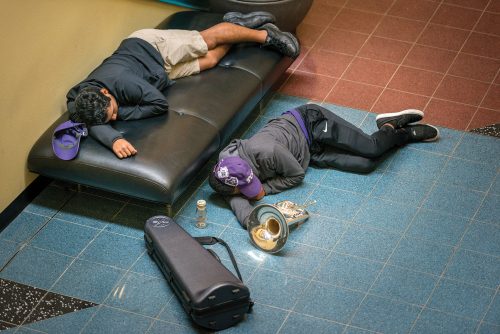
After breakfast, band members nap in the lobby of PepsiCo Recital Hall.
The Pride of TCU also trains aspiring music teachers. Youngblood, a veteran high school band director, said he designed the band’s structure as a “lab for the music majors because they’re going to teach what we’re doing when they get out.”
Youngblood’s marching band “gives [students] a real, workable environment,” said Bobby Francis, director of bands at TCU, calling the student-leadership model “significant.” He said the School of Music boasts an almost 100 percent job placement rate for music education graduates.
Learning to teach music is vital for young musicians, Francis continued, as paid performance opportunities are becoming scarce. “There might be only one job open next year in a professional orchestra in the entire world.”
But music-lovers perform despite the economic challenges. During the marching band season, Tasker played in several jazz bands. Drum majors Green and Camp played Sunday church gigs for extra cash.
“I don’t really mind,” Camp said about making time to play music, “because this is how the real world is going to be. I might as well get used to it now.”
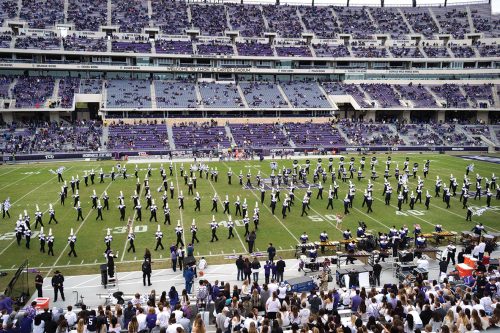
Drill designers use computer software to create precise marching band formations.
In addition to class, rehearsals and outside gigs, marching musicians have to factor for travel time. In the Fall 2015 semester, the group accompanied the football team to games in Norman, Okla., Stillwater, Okla., and Lubbock, Texas.
Youngblood explains that TCU Athletics purchases tickets for the band for away games, and the tally doesn’t follow a one-seat-per-person scale. The drum line alone occupies around 130 seats. The entire band, including showgirls, can take 400.
“Do the math on regular ticket price,” he said. “And whoa! It’s expensive.”
No one can stay behind, either, as holes in the drill formations are obvious. Each musician also contributes something musical to the show that only he can play.
Drum major Will McLaughlin said knowing your band family is relying on you builds self-confidence and a sense of responsibility. “So you’re always there, and you’re always doing as good as you can. The bar’s set so high. It makes us work harder, work smarter.”
During October’s Thursday night home field showdown against West Virginia University, the band performs “On the Floor” before a packed stadium and ESPN’s television cameras.
McLaughlin, the drum major on the north 35-yard line, conveys the tempo to the trumpeters and trombone players on the right side of the field. The musicians hold their heads straightforward to look at him, turning their bodies to change direction while following the prescribed drill. Everyone is in the right place.
Game day magic
In the cool milieu of 6 a.m. on a November Saturday, 30 yawning drummers amble to the stadium for their weekly sectional practice. With dim lights surrounding the field, rehearsal commences with the “eight on each hand” warm-up exercise.
At 7 a.m., the entire band does a final moving run-through of the season’s third halftime show, an original arrangement of pop star Pink’s “Raise Your Glass.”
Youngblood watches every step. Everyone must move the correct way at the right moment and stay in perfect tune. All good. An hour later, half of the band splits to eat a complimentary breakfast at nearby University Christian Church. The other half stays around for the Frog Walk, where they play the now-automatic cadences and chants to welcome the football players as they arrive for a midday contest against the University of Kansas.
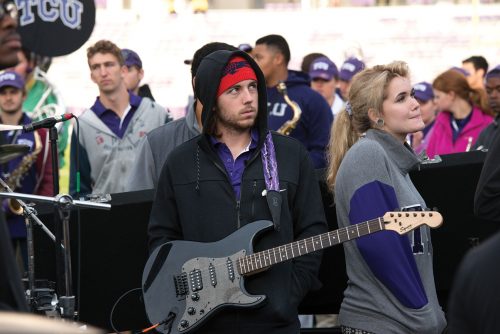
The guitar band member George Timson originally brought from home kept de-tuning in the heat, so the TCU Marching Band purchased an outdoor-friendly model and a purple “lightning” strap.
With 80 minutes until game time, uniformed drummers assemble in a line facing Frog Fountain. Echoes of their crisp and perfectly matched strokes ring off the dormitories and classrooms surrounding the Campus Commons.
Tuba and trombone players blow notes to tune their instruments. A crowd gathers. Several elementary-aged children approach the drummers to stare and mimic their hand movements.
Standing next to Scharbauer Hall, Youngblood switches on a portable P.A. system. “Line up six across.” His instruction ceases the chatter, both musical and vocal.
Following the drum line’s cadence, the band marches north from the fountain and west between Carter and Foster halls. Police officers on bicycles bring up the flanks. A swelling crowd trails through the arches of Brown-Lupton University Union.
Marching musicians step in military precision toward the stadium. They stop in Frog Alley, then turn to face thousands of people heading for the game. White hats bobbing in unison, they launch into the Offspring’s ’90s classic “Pretty Fly (For a White Guy).” The grinning flute section sings the chorus: “Give it to me baby, uh-huh, uh-huh.”
Band family
Despite the hard (and often hot) work, the marching musicians rave about being members of the Pride of TCU. “We get to share all these amazing experiences,” McLaughlin said. “So many of my best friends are in band. Everybody talks about it that way — band is family. And it’s cliché for a reason. It’s so true.”
The night before the Kansas game, Tasker and the other snare drummers gather at an off-campus house to hang out and watch movies. They take turns passing around a soundless practice pad so they can drum away and keep their hands and fingers limber.
Youngblood stays in contact all evening with the three drum majors, who operate a chain of communication for any last-minute adjustments to the pre-game schedule. “He uses lots of smiley faces,” Camp said of the band director’s texting style.
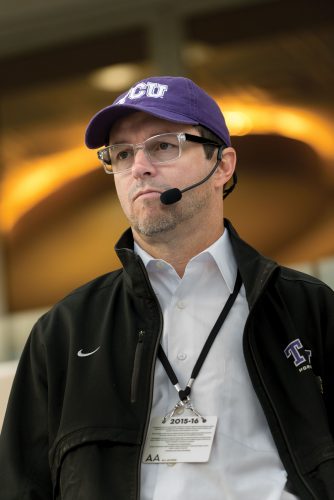
Brian Youngblood, director of the Horned Frog Marching Band, is also a drummer.
The next day’s game gets off to a rough start. Quarterback Trevone Boykin leaves with an apparent ankle injury. The band plays on, leading an enthusiastic rendition of “Riff Ram Bah Zoo” after a video board appearance by Rick Carlisle, coach of the Dallas Mavericks.
Later in the game, the stadium’s massive audiovisual system malfunctions. The band returns to its un-amplified ways, maintaining the school’s musical traditions and helping to save the day. The Frogs beat Kansas 23-17. “We do feel like we can influence the game or change momentum a little bit,” Tasker said.
The trio of drum majors said the band makes an even bigger difference away from home, when the visiting team needs all the support it can get. They cited Thanksgivings in 2012 and 2014 at Austin’s Darrell K. Royal-Texas Memorial Stadium as specific examples. (The Horned Frogs won both games.)
TCU’s athletic department also funds the band’s travel to end-of-season bowl games. In January, the Pride of TCU was in San Antonio to help spark the Alamo Bowl victory over Oregon. With the rest of the Alamodome crowd in shock after the biggest comeback win in bowl game history, the band played the “TCU Alma Mater” for the last time of the football season.
The trumpets call Horned Frog Nation to attention with a high-pitched reveille. The swelling clarinets and trombones break in to set the tone for the 88-year-old melody.
“Hail, all hail, TCU,” fans sing.
“Mem’ries sweet, comrades true.”
Just like they rehearsed in August, the saxophones up the song’s stakes.
The singing continues: “Light of faith, follow through. Praise to thee,
T. C. U.”
(courtesy of the TCU Horned Frog Marching Band)

Your comments are welcome
2 Comments
Love the TCU marching band article. They are such an important part of the atmosphere for football season. Please be aware that an endowment has been set up for the band. Contact the athletic department for more information.
Wonderful article on the band. It will be forty years this fall since I last marched. Moments and friendships that shaped my life. As a band director, I had the privilege of some of my students being in the band, even music majors. I am so thankful for being a member and to Prof, Curtis, and Preston who believed in me.
Related reading:
Personal Essay
Best Seat in the House
Reflecting on four grand years in the TCU Marching Band.
Features
Kelubia Mabatah’s Comeback
Former TCU tennis player forges on after a traumatic brain injury.